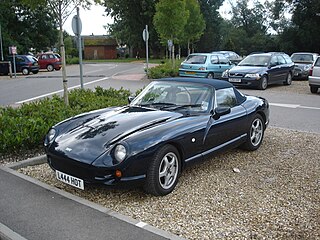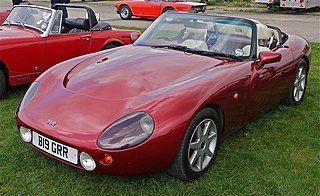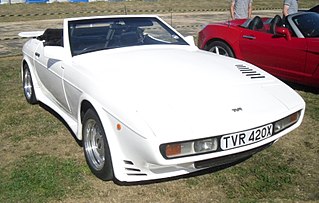
A sports car, or sportscar, is a small, usually two-seater automobile designed for spirited performance and nimble handling. The term "sports car" was used in The Times, London in 1919. According to the Merriam-Webster dictionary, USA's first known use of the term was in 1928. Sports cars started to become popular during the 1920s.

The TVR Chimaera is a two-seater convertible sports car manufactured by TVR between 1992 and 2003. The name was derived from Chimera, the monstrous creature of Greek mythology, which was made of the parts of multiple animals.

The TVR Sagaris is a sports car designed and built by the British manufacturer TVR in their factory in Blackpool, Lancashire.

Trident Cars Ltd was a British car manufacturer based originally in Woodbridge, then in Ipswich, Suffolk between 1966 and 1974, and again after being restarted in 1976 from premises in Ipswich. The new company stopped production in 1977-78.

The TVR Griffith, later models being referred to as the Griffith 500, is a sports car designed and built by TVR starting production in 1991 and ending production in 2002 with production beginning again in 2018 under a revived TVR brand.
Oliver Winterbottom is a British automotive designer who has designed cars for Lotus as well as for Jaguar and TVR.

The TVR 350SE was a sports car designed and built by TVR starting in 1990 and ending in 1991.
In 1990 TVR Engineering Limited produced a limited production run of 25 specially prepared 350's to mark the end of the era heralded by the 350i. This commemorated the previous 7 years of production during which time over a thousand 350i-model TVRs were manufactured.
The limited production 350SE was seen as the ultimate progression of the 350i in terms of both outright performance and enjoyment.

The TVR Cerbera is a sports car manufactured by TVR between 1996 and 2003. The name is derived from Cerberus the three-headed beast of Greek legend that guarded the entrance of Hades.

The TVR Tuscan Challenge is a one-make series dedicated to the second incarnation of the TVR Tuscan sports car, and takes place throughout the United Kingdom. Inaugurated in 1989, its high power-to-weight ratio, capability of reaching 190 mph (310 km/h) and loud engine noise, combined with close racing in a field consisting of over 30 cars at its peak, made the series become, at the time, the premier one-make series in the UK with an extensive TV coverage; over the years, many drivers who competed in the series moved on in major championship series and many notable drivers have guest driven in a race. The company underwent management changes in 2005, and the TVR Tuscan Challenge was merged with its owner club's series, which has been reformatted to allow for all TVR models.

The TVR Typhon is a sports car produced by the British car manufacturer TVR in their factory in Blackpool between 2000 and 2006. It is the fastest production TVR ever built. Only three were ever built. All are currently in England.
The TVR Speed Eight was the name of a normally aspirated V8 car engine designed and manufactured by TVR. The engine was intended to power the TVR Griffith and the TVR Chimaera but delays in its production meant that it powered only the TVR Cerbera and the TVR Tuscan Racer. The reason behind the engine's development and production was that in that particular time Rover was bought by BMW and Peter Wheeler the boss of TVR in that time, feared that BMW would drop the Rover V8 engine used in TVRs since the early 80's, so he contracted car engine designer Al Melling to design a brand-new V8 engine to power the TVR Cerbera as well as an engine that TVR could sell to other car manufacturers.

The TVR 420 SEAC is a sports car designed and built by TVR between 1986 and 1988. It is considered as the ultimate "wedge" TVR and is the final of TVR wedge family. Unlike the other wedges the 420 SEAC was different. The acronym SEAC stands for Special Equipment Aramid Composite, that means that more than 20% of the body was kevlar unlike the others wedges full fibreglass construction. The use of kevlar made the car more than 100 kg (220 lb) lighter without compromising the body rigidity. That, in addition to the highly tuned Rover V8 engine made the car extremely quick but had its effect on price which was twice as much as a standard 350i. In addition the SEAC models can be distinguished by the large rear spoiler and the rounder nose. By 1988 when the 420 SEAC was replaced by the even more powerful 450 SEAC about 40 cars had been built.

The TVR 450 SEAC is a sports car designed and built by TVR in a one year only run. It used the same fibreglass and kevlar body as the 420 SEAC and the same chassis. The only difference was the engine which grew to 4,5 litres and about 325 bhp (242 kW) and 435 Nm torque. As a consequence though the 450 SEAC was even more expensive to build and buy than the already expensive 420 SEAC, so about 17 were made. Curiously, rumour has it that more SEAC's are on the road now than were manufactured in the first place, that is because many wedges were converted to 450 SEAC spec afterwards.

The TVR 390SE is a sports car designed and built by TVR. It was introduced in October 1984. It featured many novelties not found in other 'Wedge' TVRs before and was also the most powerful one yet. It never received British Type Approval, so technically speaking the 390SE was just a 350i with special equipment fitted.

The TVR Tasmin is a sports car designed by TVR and built in the United Kingdom by that company from 1980 to 1987. It was the first of TVR's "Wedge"-series which formed the basis of its 1980's model range. The Tasmin/280i was available as a 2-seater coupé, as a 2+2 coupé and as a 2-seater convertible.

The TVR M series is a line of sports cars built by automaker TVR between 1972 and 1979. The series replaced the outgoing TVR Vixen and Tuscan models, and is characterized by a common chassis and shared body style. As with other TVR models before and since, the M-series cars use a front mid-engine, rear-wheel drive layout and body-on-frame construction. The bodies themselves were built from glass-reinforced plastic (GRP). The era of the M series is commonly associated with Martin Lilley who, together with his father, took ownership of the company on 30 November 1965.

In 1982 TVR's then new owner Peter Wheeler found himself wanting more power than the Cologne V6-equipped Tasmin 280i could offer. Thus, based on the existing car the Tasmin 350i appeared in August 1983. Using the same chassis and body, a 3.5-litre Rover V8 was installed. After a year, the "Tasmin" part of the name was dropped and the car became plain TVR 350i.

The TVR 400/450SE was a series of open sports cars designed and built by TVR in the late eighties and early nineties. The 400SE was introduced in 1988, the 450SE a year later. The 400SE was the last of the Wedges built, with the last cars being produced in late 1991 and registered in 1992. There were also special versions built, with two Sprintex supercharged 400SX built by dealer 'Northern TVR Centre' in 1989, and three Griffith engined 430SEs were constructed in 1991.

Broadspeed Engineering Ltd was a British automobile tuning and engineering company that operated from Sparkbrook, Birmingham, England, principally during the 1960s and 1970s. It was started and run by Ralph Broad, and first became well known for its success in campaigning MkI BMC Minis during the early 1960s. The company also offered a variety of different road- and race-tuning packages for BMC and Ford engines.



























